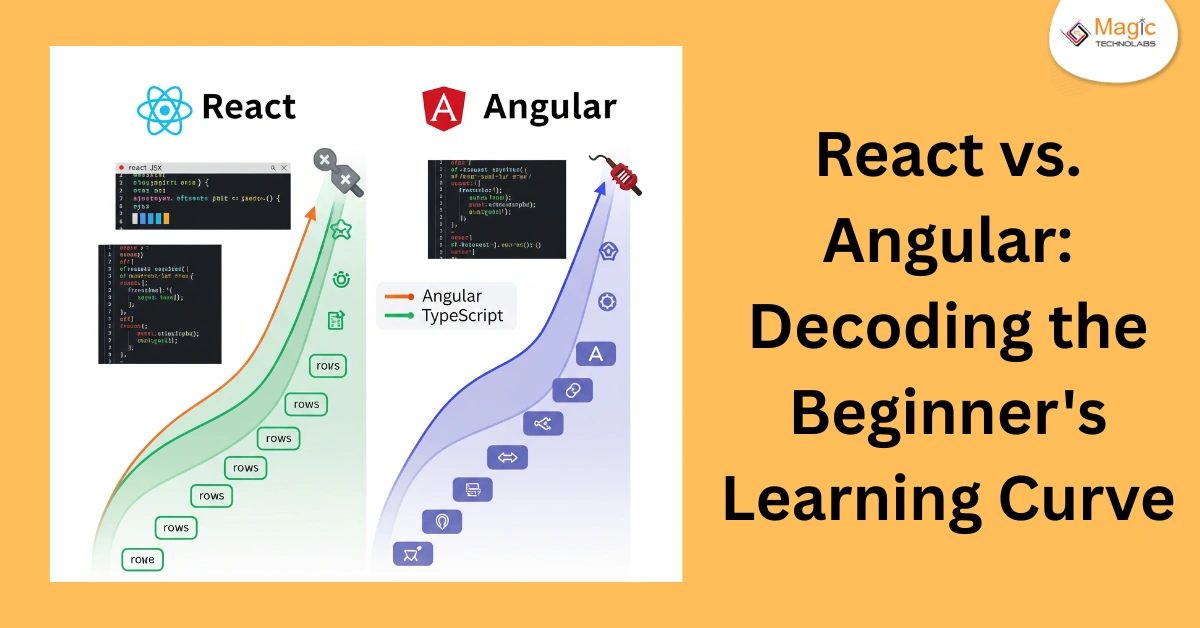I will be honest; it seems like settling down between React and Angular is to pick a side in a developer debate club. When you are only on the beginning of your web development path, the choice becomes even more difficult.
Both frameworks are strong, popular and can construct high performing web apps. However, the way in which a beginner may proceed can differ greatly when speaking about convenience of learning, developer experience, and application in the real life.
OK, you got it? Let us compare this: React vs. Angular and which one is easier to use, in fact?
What is the Learning Curve Really All About?
What does the term learning curve mean in web development anyway? Let us clarify that before we delve into it.
It is not simply a contest by who can write Hello, World fastest.
How intuitive the syntax feels
How much setup is required
How fast you see results
How easily concepts like components, state, and routing make sense
React: Simple to Start, Complex to Master
React is a stretching JavaScript library made by Facebook. It adds concern to only view layer (UI), which also implies that you will have to import some other libraries to handle things such as routing and state management.
The reason React is easier to learn whether you are a beginner or experienced.
JSX feels like HTML + JavaScript
You write familiar HTML-like code inside JavaScript—it feels natural for beginners.
Flexible and minimal
React is not very structure-oriented. Start small and grow big.
Huge community & tons of tutorials
Stack Overflow and YouTube are packed with React help.
What Can Be Challenging?
Too many choices
You’ll need to pick your own libraries for routing, state (Redux? Context?), and more.
JSX syntax can be weird at first
Mixing HTML with JavaScript can confuse some learners.
Angular: All-in-One, But Heavier to Learn
Angular is a complete framework made by Google. It is bundled with everything that you need including routing, state management, forms, and testing.
Why Beginners Might Love Angular
Complete package
No need to hunt for extra libraries. Angular has it all.
Strong structure and consistency
Great for teams and scalable projects.
Powerful CLI (Command Line Interface)
Generate components, services, and modules with ease.
Where Beginners Struggle
Steep initial learning curve
TypeScript, decorators, dependency injection—it’s a lot to digest.
Verbose syntax
Writing simple things can feel unnecessarily complex at first.
Opinionated structure
You need to follow Angular’s way of doing things, which may limit flexibility for small apps.
React vs. Angular: Learning Curve Comparison
|
Feature |
React |
Angular |
|---|---|---|
|
Setup Time |
Fast |
Moderate |
|
Flexibility |
High |
Moderate |
|
TypeScript Required |
Optional |
Yes |
|
Structure |
Unstructured |
Structured |
|
Learning Curve |
Gentle (initially) |
Steep (initially) |
|
Docs & Community |
Excellent |
Excellent |
Which one then should YOU choose?
React may be more familiar and easier to work with if you are a self-taught developers or even for attaching your feet in the waters of front-end development.
When designing scalable applications and working with a team, Angular is a comprehensive framework that you can use right off the shelf (even though it takes longer at first).
In any case, there are no wrong decisions at the end of the day. React and Angular get jobs, have numerous supporting libraries, and are worth learning.
Beginner tip: You should start with one, create some small applications, and it will be no crime to dig into the other one in the future. Coding more means making everything easy.
Final Thoughts
When it comes to React vs. Angular, neither of these frameworks can be a winner, but a developer who learns and develops with each line of code in it.
Therefore, choose your own way, and remain an explorer, and keep developing.
As learning to code is not supposed to be a challenge, but an experience.
















